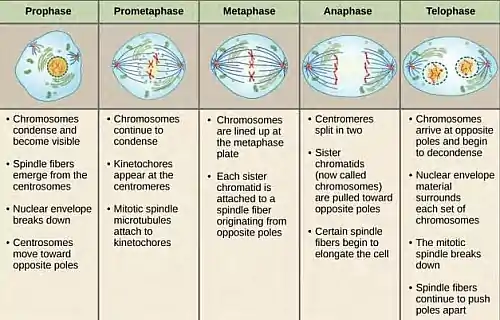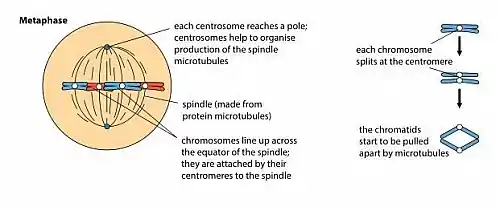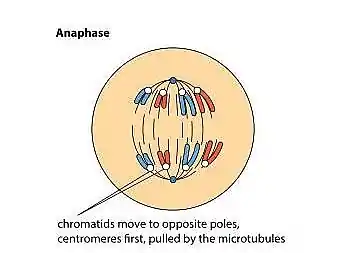Mitosis is the most common type of nuclear division and leads to the formation of two genetically identical daughter nuclei; the other type of nuclear division is called Meiosis and leads to four variable daughter cells.
Mitosis is part of the cell cycle and occurs after the G2 phase of the cell cycle and is followed by cell division (cytokinesis where the cell divides and separates into).
It is worthy of note that Mitosis and cell division are not the same. While cell division is the separation of the cell membranes to form separate cells, Mitosis is the division of the nucleus into two nuclei and occurs before cell division so that each separated cell can have a nucleus.
Table of Contents
Definition
Mitosis can be defined as the form of nuclear division that leads to the production of two genetically identical daughter nuclei. Each nucleus contains the same number of chromosomes as the parent nucleus. This process is part of the cell cycle.
What is mitosis?
Mitosis is a multi-step process that requires the duplication of chromosomes which are then aligned and separated to the opposite poles of a cell in order for the cell to divide to give rise to two new identical daughter cells. Chromosomes that each daughter cell will have are normally replicated during the preceding S phase of interphases. The interphase is the period before cell division where the cell grows and performs its normal function prior to when a signal will be received to start dividing. There are normally four phases of mitosis which are prophase, anaphase, metaphase, and telophase. The explanation of these four steps will be done below.

What happens during the process of mitosis?
The process begins with Prophase and ends with Telophase and this is best described using diagrams which are shown below. Mitosis, in reality, is a continuous process and it has been divided into steps or stages just to help in understanding it. The mitosis diagrams shown have been simplified so as to make it easy as the number of chromosomes shown are actually many but have been reduced in the diagrams to four. The diagrams you are seeing are showing the nucleus and not the cytoplasm of the cell because the process of mitosis occurs in the nucleus of cells that have the ability to divide.
The chromosomes in plant cells behave in a similar manner as the chromosomes of animal cells, even though the plant cells do not contain centrosomes and a new cell wall always forms between the daughter nuclei after nuclear division. The whole process of mitosis can be viewed or observed using a light microscope.
Definition of terms used in the explanation of mitosis
For you to easily understand this process, there is a need to explain some terms used in the description of the process.
- Daughter cells: Daughter cells in mitosis refer to the cells that are formed from the parent cell. A parent cell is a single cell that will divide itself into two to form the daughter cells. Please note that after mitosis, you have two cells from a single cell. It is not as if the parent cell is different from the two daughter cells formed; it is as if you cut a single orange to form two equal halves and the equal halves now are called daughter cells.
- Chromatids: Chromatids are the strands of replicated chromosomes that become the chromosomes when they contract
- Microtubules: Microtubules are support fibers for the movement of chromosomes during mitosis
- Centromeres: Centromeres are needed for the separation of chromatids during mitosis and they are visible as constrictions that serve as sites of attachment of spindle microtubules.
- Kinetochore: this helps to bind bundles of microtubules called spindle fibers as they extend from the kinetochores to the poles of the spindle during mitosis
What is the purpose of mitosis?
The significance of mitosis is to produce cells that are similar in function and structure to replace worn-out cells or damaged cells of the body.
Functions of mitosis
- Mitosis helps in growth: when the fusion of spermatozoon and ovum occurs, they form a zygote which then starts growing to form a human being or a baby of any animal that has many cells (multicellular organisms). The organisms or human beings grow by the process of mitosis occurring in different parts of the body
- It helps in replacement of cells and tissue repair: friction occurs as our bodies come in contact with others or hard surfaces and this causes damage to the skin and other parts of the body. Even while we eat, some parts of the intestines slough off, and even when we urinate, the urinary tract slough off. There is a need for the body to replace these damaged parts of the body or repair the worn-out body tissues. The body does this by sending a signal to the cell concerned to start cell division and mitosis. In fact in some animals, the whole part of the body can be regenerated such as the starfish regenerating a whole arm.
- The process of mitosis functions in asexual reproduction: mitosis is the basis of asexual reproduction by unicellular organisms and also the basis of cloning in biotechnology. Budding in multicellular organisms is a form of asexual reproduction and unicellular organism such as amoeba also reproduces asexually.
- It serves an important function in the immune response: the cloning of B-lymphocytes and T-lymphocytes during the immune response occurs through the process of mitosis.
Where does mitosis occur?
Mitosis occurs in almost all cells of the body with the exception of the cardiac tissue and nerve tissues (these two tissues do not undergo mitosis because they remain dormant in the G0 phase of the cell cycle). The process of mitosis occurs inside the nucleus of dividing cells.
Some of the body tissues take a longer period of time before the cells divide while others take a shorter time and still others do not even divide at all. Epithelial tissues such as that of the intestines and that of the skin undergo mitosis within a short period of time (there is rapid cell turnover) this is the reason why an injury to the mouth or skin heals faster than muscles or any other tissue.
Tissues such as Nerves and cardiac muscles do not divide and this explains why a damaged nerve cannot be repaired again and permanent paralysis of the muscle supplied by the nerve occurs such as in paralysis caused by poliomyelitis. It is also the same reason why heart attack following ischemia leads to heart failure because the heart muscles cannot divide to form new ones again.
Mitosis stages
- Prophase (the first stage)
- Metaphase (the second stage)
- Anaphase (the third stage)
- Telophase (the fourth and last stage)
Explanation of the 4 stages of mitosis in order (Phases of Mitosis)
The explanation of mitosis is best done with diagrams and pictures which can be seen below. Take note of the position of the chromosomes at each stage of mitosis.
Prophase stage of Mitosis: the centrosomes begin to move to opposite poles
What is prophase?
Mitosis begins with prophase (it is the first stage of mitosis) and it is the longest phase of mitosis. In order for prophase to start, several events must occur to enable access to the chromosomes in the nucleus such as the breaking of the nuclear envelope into small vesicles, the Golgi apparatus, and endoplasmic reticulum fragment and disperse to the periphery of the cell while the nucleolus disappears.
What happens in the prophase?
- The centrosomes begin to move to opposite poles of the cell.
- The microtubules that form the basis of the mitotic spindle extend between the centrosomes, pushing them farther apart as the microtubule fibers lengthen.
- The sister chromatids (joined by cohesins) begin to coil more tightly and become visible under a light microscope
- At the centromere region of each chromosome, a large protein complex called the kinetochore serves as a site for attachment to microtubules.
- Late in prophase, lamins and inner nuclear membrane are phosphorylated, causing the nuclear lamina and nuclear pore complexes to disassemble and disperse in cytoplasmic membrane vesicles

Metaphase stage: the chromosomes condense and move to the center
Prometaphase
This is not a major stage of mitosis as it occurs briefly before metaphase. In this stage, the chromosomes attach to spindle microtubules at their kinetochores and begin to be moved.
Metaphase (What happens during this phase?)
- During metaphase, the chromosomes condense further and attach to the mitotic spindle at large electron-dense protein complexes called kinetochores at each centromere
- The cell is now more spherical and the chromosomes are moved to align at its center (equatorial plane)

Anaphase stage: the chromosomes move to the poles
Anaphase (What happens in this stage?)
- Sister chromatids (now called chromosomes) separate from each other to become individual chromosomes that are pulled toward the spindle poles.
- The poles move apart and the kinetochore microtubules get shorter

Telophase stage of Mitosis: the chromosomes begin reverting and the nuclear envelope begins to reassemble
Telophase stage (What happens in telophase?)
- The two sets of chromosomes are at the spindle poles and begin reverting to their de-condensed state
- The spindle de-polymerizes and the nuclear envelope begins to reassemble around each set of daughter chromosomes
- A belt-like contractile ring of actin filaments associated with myosins develops in the peripheral cytoplasm at the cell’s equator.
- During cytokinesis (at the end of telophase), constriction of the ring produces a cleavage furrow and progresses until the cytoplasm and its organelles are divided into two daughter cells, each with one nucleus